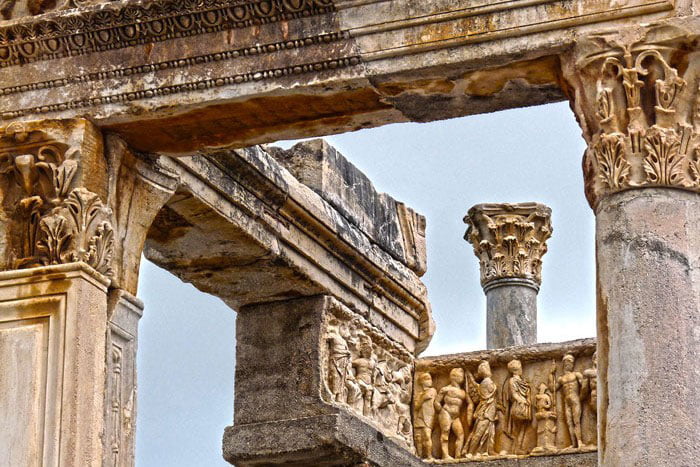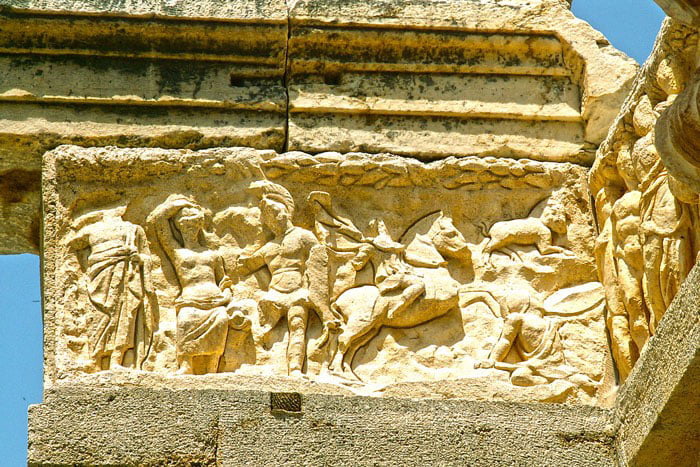Explore Hadrian Temple with Ephesus Daily Tours
Introduction to Hadrian Temple
Hadrian Temple is one of the most famous stops on Ephesus daily tours. This ancient structure was found in 1956 by the Austrian Archaeological Institute. Because of its great condition and rich history, it was rebuilt in 1957 and 1958.
Many parts of the original temple were used in the rebuilding. Some modern materials were also added to make it look complete. A big conservation project started in 2012. It was supported by the J. M. Kaplan Fund and finished in 2014.
All the photos in this article were taken in April 2015, after the project ended. You can explore this wonderful site with our Ephesus day tour.

The Dedication of the Temple
An inscription found on the top of the temple tells us to whom it was dedicated. It honored Artemis Ephesia, Emperor Hadrian, and the people of Ephesus. The person who paid for the temple was Poplius Vedius Antoninus Sabinus, an important local leader.
Structure and Design
Hadrian Temple is small but full of details. It has four columns at the front. This style is called tetrastyle prostyle. The decorations are rich and full of meaning. Two Corinthian columns and two side pillars hold up the top of the temple.
The top part has a curved Syrian-style pediment. This area shows flower patterns and the image of Tyche, the goddess of victory. Tyche wears a crown with the city walls of Ephesus, a symbol you will often see during customized Turkey tour.

Inside the Temple
Behind the arch is the pronaos, the front room of the temple. The door here has a semi-circle carving above it, called a tympanum. This carving shows a woman figure, likely Medusa, surrounded by leaves and scrolls.
The door leads to the cella, the temple’s inner room. It is 7.5 meters wide and 5 meters long. A barrel-shaped ceiling covers the room.
The Story of Prince Androclus
The pronaos has a special decoration. A frieze of four marble slabs shows how Ephesus was founded. This story is important in Ephesus daily tours.
The art here was added in the 4th century AD. It did not belong to the original temple. Today, the real frieze is in the Ephesus Museum. A copy is placed at the site.

Slab One: The Oracle and the Boar
The first slab shows five people. On the left is Zeus and a Nymph, the spirit of a spring. In the center, Prince Androclus rides a horse and attacks a wild boar. A fallen soldier lies under the boar.
The myth tells how Androclus, son of an Athenian king, wanted to find a new home. He asked the Oracle of Apollo for advice. The Oracle told him to follow signs of fish and a boar.
He reached the coast near Ephesus. While cooking fish, one jumped out and started a fire. From the fire came a wild boar. Androclus killed the animal and founded the city there. This story is often told during jeep safari Bulgaria trips and cultural tours.
Slab Two: Heracles and the Amazons
The second slab shows a Roman Emperor offering a sacrifice. He wears a military robe and is crowned by Nike, the goddess of victory.
Next to him stands a man who might be Theseus. Near him is Heracles. Four Amazon women run from them. The Amazons once found safety in the Temple of Artemis in Ephesus. They were escaping both Heracles and Dionysus, as told on our Ephesus day tour.
Slab Three: Dionysus and the Amazons
This slab shows three fleeing Amazons. Dionysus, the god of wine, stands in the middle with a Satyr. On the right, Pan holds a long staff. A dancing Maenad nearby plays a cymbal.
In Ephesus daily tours, guides often explain how gods, nature, and art mixed in Ephesus stories.
Slab Four: The Gods and the City’s Founder
The final slab includes many gods. From left to right are:
Dea Roma, Selene (Moon), Helios (Sun), Apollo, Artemis, Heracles, Dionysus, Hermes, Aphrodite, Ares, Athena
In the center stands Androclus with his loyal dog. His image appeared in many places in Ephesus. Coins also showed him and the boar.
A statue of him can be seen at the Fountain of Trajan. He stands proudly with his dog. These figures are important parts of Ephesus’ identity, as told on Ephesus daily tours. For more questions, feel free to contact us.
Visit Hadrian Temple Today
Hadrian Temple is a true wonder of ancient Ephesus. It mixes beautiful design, myth, and history in one place. The stories told through its carvings bring the past to life.
Join our Ephesus daily tours to learn more. Walk through the same paths once used by emperors and heroes. Don’t miss this chance to explore the magic of the ancient world with a professional guide.




